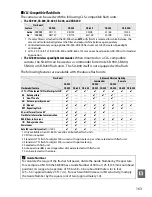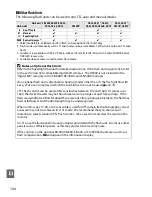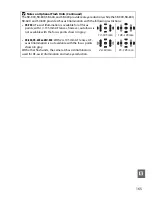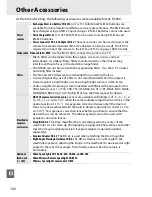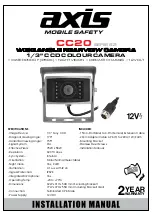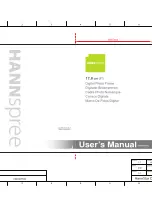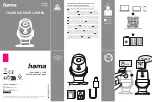
175
n
To prevent mold or mildew, take the camera out of storage at least once a month. Turn the
camera on and release the shutter a few times before putting it away.
Store the battery in a cool, dry place. Replace the terminal cover before putting the battery
away.
Notes on the monitor
: The monitor may contain a few pixels that are always lit or that do not light.
This is common to all TFT LCD monitors and does not indicate a malfunction. Images recorded
with the product are unaffected.
Images in the monitor may be difficult to see in a bright light.
Do not apply pressure to the monitor, as this could cause damage or malfunction. Dust or lint
on the monitor can be removed with a blower. Stains can be removed by wiping lightly with a
soft cloth or chamois leather. Should the monitor break, care should be taken to avoid injury
from broken glass and to prevent liquid crystal from the monitor touching the skin or entering
the eyes and mouth.
Moiré
: Moiré is an interference pattern created by the interaction of an image containing a
regular, repeating grid, such as the pattern of weave in cloth or windows in a building, with the
camera image sensor grid. If you notice moiré in your photographs, try changing the distance
to the subject, zooming in and out, or changing the angle between the subject and the
camera.
Batteries
: Dirt on the battery terminals can prevent the camera from functioning and should be
removed with a soft, dry cloth before use.
Batteries may leak or explode if improperly handled. Observe the following precautions when
handling batteries:
Turn the product off before replacing the battery.
The battery may become hot when used for extended periods. Observe due caution when
handling the battery.
Use only batteries approved for use in this equipment.
Do not expose the battery to flame or excessive heat.
After removing the battery from the camera, be sure to replace the terminal cover.
Charge the battery before use. When taking photographs on important occasions, ready a
spare EN-EL9a battery and keep it fully charged. Depending on your location, it may be
difficult to purchase replacement batteries on short notice.
On cold days, the capacity of batteries tends to decrease. Be sure the battery is fully charged
before taking photographs outside in cold weather. Keep a spare battery in a warm place and
exchange the two as necessary. Once warmed, a cold battery may recover some of its charge.
Continuing to charge the battery after it is fully charged can impair battery performance.
Used batteries are a valuable resource. Please recycle used batteries in accord with local
regulations.
Summary of Contents for D3000
Page 1: ...DIGITAL CAMERA User s Manual ...
Page 42: ...X 24 ...
Page 52: ...34 s ...
Page 84: ...66 z ...
Page 174: ...156 w ...
Page 215: ......



